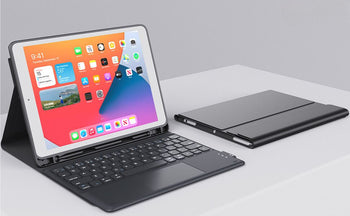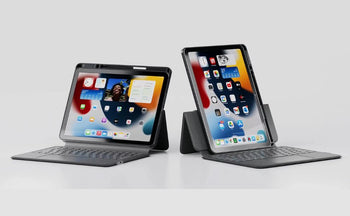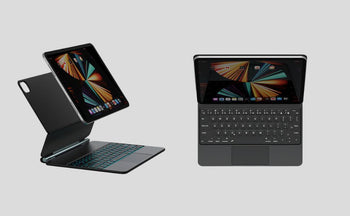Deciding between an iPad Pro vs MacBook Pro can be tricky. Both are powerful Apple devices, but they shine in different ways.
The MacBook Pro works better for heavy tasks like video editing and coding thanks to its cooling system and laptop design with more ports. The iPad Pro stands out with its touch screen, Apple Pencil support, and go-anywhere portability that makes it great for creative work and entertainment.
Your best choice comes down to how you'll use it—do you need traditional computing power or the flexibility of touch? Whether you're a professional creator or casual user, understanding these differences will help you spend your money wisely.
Read on to find your ideal Apple companion!
iPad Pro vs. MacBook Pro Comparison
|
Feature |
iPad Pro |
MacBook Pro |
|
Processor |
M4 chip (9-10 core CPU) |
M4 Pro/Max (12-16 core CPU) |
|
Memory |
8GB (256GB/512GB models) or 16GB (1TB/2TB models) |
24GB-128GB unified memory |
|
Storage Options |
256GB, 512GB, 1TB, 2TB |
512GB, 1TB, 2TB, 4TB, 8TB (M4 Max) |
|
Display |
Tandem OLED (Ultra Retina XDR), ProMotion 120Hz, 1000-1600 nits |
Liquid Retina XDR, ProMotion 120Hz, 1000-1600 nits peak |
|
Ports |
1x Thunderbolt/USB 4 |
3x Thunderbolt 4/5 ports |
|
Battery Life |
Up to 10 hours of web browsing |
Up to 22 hours video streaming (14-inch) |
|
Weight |
1.5 pounds (12.9") |
3.4-3.6 pounds (14-inch) |
|
Touch Interface |
Touchscreen + Apple Pencil Pro support |
Force Touch trackpad (no touchscreen) |
|
Operating System |
iPadOS |
macOS |
|
External Display Support |
Supports one external display up to 6K |
Up to four external displays (M4 Max) |
|
Cooling System |
Passive (no fan) |
Active (with fans) |
|
Audio |
Four-speaker audio |
Six-speaker sound system |
|
Unique Features |
Apple Pencil Pro, Center Stage camera, optional cellular |
Better sustained performance, more ports, native desktop apps |
|
Best For |
Creative work, portability, touch interface |
Professional workflows, multitasking, intensive processing |
Your best choice depends on your specific needs—traditional computing power with macOS or the flexible touch interface with iPadOS.
iPad Pro and MacBook Pro: How They Differ
The new M4 iPad Pro is incredibly powerful! It might make you wonder if you need a MacBook Pro at all.
The iPad Pro uses the newer M4 chip, while current MacBook Pros use M4 Pro or Max chips. Both handle everyday tasks smoothly with no lag when browsing, streaming, or working with documents.
RAM Comparison:
- iPad Pro: 8GB or 16GB
- MacBook Pro: 24GB to 128GB
For heavy multitasking and professional apps, the MacBook Pro has a clear advantage with much more memory. Both devices have impressive graphics performance for editing videos, playing games, and working with 3D models.
In day-to-day tasks, you probably won't notice much difference. Both are more than capable for basic work. However, the MacBook pulls ahead during long, intensive tasks thanks to its active cooling system with fans. The iPad Pro uses passive cooling (no fan).
Battery life differs significantly - the iPad Pro offers about 10 hours, while the MacBook Pro can last up to 22 hours.
Display
When choosing between these devices, the display might be your deciding factor. Both offer amazing screens designed for different uses.
The MacBook Pro features a Liquid Retina XDR display with crisp, detailed images. Text appears super sharp, and colors look vibrant when typing papers or editing photos. Screen sizes range from 14 to 16 inches depending on your model.
The 12.9-inch iPad Pro now features a Tandem OLED (Ultra Retina XDR) display with ProMotion technology. This means smoother scrolling and more responsive touch interactions. The screen refresh rate adjusts automatically to save battery while still looking great during fast-moving content.
Both devices offer ProMotion 120Hz refresh rates and 1000-1600 nits brightness. The iPad Pro screen supports the Apple Pencil Pro, making it perfect for digital art and note-taking.
MacBook screens work naturally with the built-in trackpad for precise control. The iPad's touch-first interface works best with direct finger input, though it can connect to a trackpad too.
Your choice depends on how you'll use your device. Need something for traditional computer tasks? The MacBook feels more natural. Want something versatile for creative work? The iPad Pro might win you over.
Portability
CHESONA ArmorDock Keyboard Case for iPad Pro
When you're always on the go, how your device feels in your bag matters big time. The iPad Pro weighs just around 1.5 pounds (for the 12.9" model), while the MacBook Pro 14" comes in at about 3.5 pounds. That difference is significant when carrying your tech all day.
Battery life is where things get interesting. The MacBook Pro provides up to 22 hours of video streaming before needing a charge. Your iPad Pro will need charging after about 10 hours - still good, but not MacBook-level impressive.
The Magic Keyboard adds both weight and capability to your iPad Pro setup. With it attached, your iPad becomes more laptop-like but also heavier.
Quick Comparison:
- iPad Pro: Super light, can be used as a tablet or with keyboard, smaller footprint
- MacBook Pro: Better battery life, slightly heavier, always in laptop form
The iPad Pro takes up less space on airplane tray tables and coffee shop counters. You can even hold it comfortably in one hand when reading or taking notes.
Your premium device deserves premium protection. Read our article: How to protect your iPad Air M3 with a keyboard case to find the perfect accessory for your needs. Level up your tablet experience today!
Creative Professional Tools and Workflow Options
Both devices offer awesome tools for creative work, but they shine in different ways.
iPad Pro gives you that hands-on feeling with the Apple Pencil Pro. Drawing directly on screen feels natural for digital artists and designers. Many creatives say it's like drawing on paper but better!
The iPad versions of creative apps have improved a lot recently. You can edit photos with your finger or Apple Pencil, making adjustments very intuitive. For quick edits on the go, iPad Pro is hard to beat.
MacBook Pro dominates for serious professional work. The larger screen and powerful processors handle large projects without slowing down. You'll appreciate this if you work with lots of high-resolution files.
Here's a quick comparison:
|
Feature |
iPad Pro |
MacBook Pro |
|
Drawing |
Excellent (with Apple Pencil) |
Limited (requires tablet) |
|
Photo Editing |
Good for basic/medium tasks |
Excellent for professional work |
|
Music Production |
Basic to intermediate |
Professional grade |
|
Portability |
Superior |
Good |
Your workflow matters most! If you often sketch ideas or want to create anywhere, iPad Pro is excellent. If you need serious processing power for complex projects with multiple displays, MacBook Pro is your best bet.
Software
When choosing between an iPad Pro and MacBook Pro, the operating systems make a huge difference in your daily experience.
iPadOS is built for touch. You swipe, tap, and pinch your way through tasks. It feels natural if you're used to using a phone. The system is simpler but has some limits on how you can organize your work.
macOS gives you more freedom. You can have multiple windows open side by side, and you can organize your files however you want. When doing complex work, this flexibility helps a lot.
Multitasking Differences:
- iPadOS: Limited window management with Split View and Slide Over
- macOS: True windowing system with multiple desktops
iPadOS has improved its multitasking, but it still can't match macOS. You can't have as many apps visible at once, which might slow down your work when doing complicated tasks.
App selection differs too. While both have many apps, macOS lets you install software from anywhere. iPadOS requires everything to come through the App Store, with stricter rules.
For creative work, the iPad Pro lets you draw directly on the screen with the Apple Pencil Pro. MacBooks don't have touchscreens at all.
If you mainly browse, write, and use basic apps, iPadOS might be perfect. For coding, advanced video editing, or using specialized software, macOS will probably suit you better.
Power users need serious storage solutions. Read our article on: How to add 2TB of storage to your iPad, that walks you through maximizing your device's capacity. Never run out of space for your creative projects again!
Connectivity
The port situation is very different between these devices and might affect how you work.
The MacBook Pro wins the port battle easily. You get three Thunderbolt 4/5 ports that let you connect to displays, storage, and other accessories at the same time. No juggling adapters when you need to charge and use other devices!
iPad Pro offers just one Thunderbolt/USB 4 port. While it supports many accessories, you'll need adapters or a hub to connect multiple devices. This can slow you down when trying to work quickly.
Port Comparison:
|
Device |
Thunderbolt Ports |
Other Features |
|
MacBook Pro |
3 ports |
Better sustained performance |
|
iPad Pro |
1 port |
Optional cellular connectivity |
The MacBook also offers much better multi-display support. You can connect up to four external monitors with the M4 Max model. The iPad Pro supports just one external display up to 6K resolution.
Battery life matters for working on the go. MacBooks deliver up to 22 hours, while iPads offer about 10 hours. This means your MacBook keeps working when your iPad needs charging.
Wireless connectivity is solid on both devices, so you can stay connected wherever you work.
Price-To-Performance Value Comparison
CHESONA Backstand Keyboard Case for iPad Pro 13'' (M4) 2024
When deciding between these devices, the price tag definitely matters. The iPad Pro starts at a lower price than the MacBook Pro, but that's not the full story.
To make your iPad Pro work like a laptop, you'll need to add a keyboard. This extra purchase pushes the total cost higher than you might expect.
The MacBook Pro offers more memory options (24GB to 128GB) compared to the iPad Pro's maximum of 16GB. This extra memory makes a big difference when working with large files or multiple apps.
For battery life, MacBooks win big. You'll get up to 22 hours on a MacBook Pro compared to only 10 hours on the iPad Pro. That's more than double!
The iPad Pro does offer some features the MacBook doesn't have - like a touchscreen and pencil input. These might be worth the premium if you're an artist or designer.
Performance-wise, both devices pack serious power with M4 chips. But the MacBook's cooling system with fans lets it maintain peak performance longer during intense tasks. The iPad Pro has no fans, which can limit performance during long, demanding work.
Still undecided after reading our comparison? Check out our guide: Can the iPad Pro Replace Your Laptop? for real-world testing and practical advice. Discover if your workflow fits the tablet lifestyle!
Finding Your Perfect Apple Pro Device

Choosing between an iPad Pro and MacBook Pro can be tricky. Both are powerful devices, but they serve different needs.
First, think about how you'll use your device. Are you mainly browsing, watching videos, and doing light work? The iPad Pro might be your best bet.
Do you need to run professional software or multitask with many windows open? The MacBook Pro would serve you better.
Form factor matters too! The iPad Pro is super portable at just 1.5 pounds and has a touchscreen with Apple Pencil support. Great for artists and note-takers.
The MacBook Pro gives you a traditional laptop experience with more ports and better cooling. Perfect for video editors and developers.
|
Feature |
iPad Pro |
MacBook Pro |
|
Weight |
1.5 pounds |
3.4-3.6 pounds |
|
Battery |
10 hours |
22 hours |
|
Touch input |
Yes + Apple Pencil |
No (trackpad only) |
|
Cooling system |
Passive (no fan) |
Active (with fans) |
|
Operating system |
iPadOS |
macOS |
Your lifestyle matters too. If you travel a lot, the iPad Pro's lightweight design is a game-changer. The newest M4 iPad Pro is incredibly powerful for its size.
But remember, iPadOS isn't macOS. Some tasks are just easier on a Mac, even though the gap is getting smaller with each update. Think about the apps you need and how you like to work before making your choice.
Future-Proofing Your Apple Pro Investment

CHESONA Levitate Series Keyboard Case for iPad Pro 12.9 Inch & Air 13 (M2), Black
When spending big on tech, you want it to last. MacBooks typically have a longer useful life, while iPads may need replacement sooner.
Protecting your investment matters too. Quality accessories like protective cases from Chesona can keep your iPad looking new while adding functionality. The right case can offer features like backlit keyboards and multi-touch trackpads that help your iPad work more like a laptop.
The M4 chips in both devices are powerful, but MacBooks handle heavy workloads better over time. For artists and note-takers, the iPad Pro with a good protective case can preserve both function and appearance.
Your usage matters most. If you mainly browse, watch content, and take notes, an iPad Pro with the right protective case might serve your needs longer than you'd expect.
Frequently Asked Questions
How do the screen sizes and displays compare between the latest iPad Pro and MacBook Pro models?
The iPad Pro comes in 11-inch and 12.9-inch models. The 12.9-inch version features a mini-LED display with amazing contrast and brightness.
MacBook Pro offers 14-inch and 16-inch options with Liquid Retina XDR displays. Both devices support ProMotion technology with 120Hz refresh rates for super smooth scrolling.
The iPad Pro has a touchscreen with Apple Pencil support, which the MacBook doesn't offer. For artists and note-takers, this touch capability is a game-changer.
Which is more cost-effective for professional video editing - the iPad Pro or the MacBook Pro?
The MacBook Pro is more cost-effective for serious video editing despite its higher starting price. It handles complex projects better with more RAM options and better thermal management.
iPad Pro with LumaFusion or iMovie works great for shorter videos or quick edits. But for long 4K projects, the MacBook Pro's ability to connect to multiple displays and external storage makes workflow much smoother.
The MacBook also supports more professional software like Final Cut Pro and Adobe Premiere without limitations. This makes it the better long-term investment for video professionals.
Can the iPad Pro replace a MacBook Pro for a full-time content creator, or are there limitations?
The iPad Pro can replace a MacBook for some content creators, especially those focused on illustration, photography, or mobile video. The Apple Pencil makes it excellent for digital art and photo editing.
However, limitations exist in file management and multitasking. You might struggle with complex workflows that require multiple windows open at once or specialized software not available on iPadOS.
Content creators who need to connect multiple peripherals or run desktop-class software will hit walls with the iPad Pro, despite its powerful M-chip processor.
For someone constantly on the move, which device offers better portability and battery life - the iPad Pro or the MacBook Pro?
The iPad Pro wins for portability at just 1.5 pounds (11-inch) versus the MacBook Pro's 3.5 pounds (14-inch). You can easily slip it into a small bag or even hold it one-handed for hours.
Battery life is comparable between both devices, with around 10-12 hours of web browsing. The iPad Pro may edge out slightly longer when watching videos or doing light tasks.
Cellular connectivity options on the iPad Pro give you internet access anywhere without hunting for Wi-Fi, making it more versatile for truly mobile workers.
What unique features does the MacBook Pro offer that might sway a gamer or creative pro away from choosing an iPad Pro?
The MacBook Pro offers serious gaming advantages with better cooling systems for sustained performance and support for external GPUs.
You can connect gaming peripherals and access a wider library of Mac-compatible games.
For creative pros, the MacBook supports industry-standard software with no mobile limitations.
Programs like Cinema 4D, Maya, and the full Adobe Creative Suite run natively without compromise.
The multiple Thunderbolt ports let you connect specialized equipment like audio interfaces, capture cards, and high-end monitors.
This expandability is crucial for professionals who need a complete workstation.





















